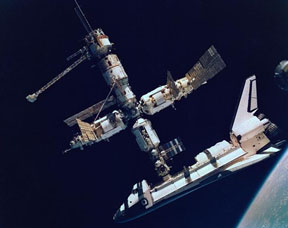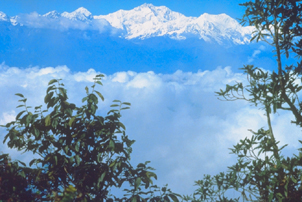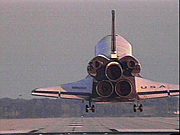When the ISS is complete, it should look something like this.
Click on image for full size
Courtesy of NASA
U.S. is Fed Up with Russia
News story originally written on February 4, 2000
Will Russia ever put the service module for the International Space Station in space? NASA officials want an answer from the Russian government. The necessary service module is currently waiting to be launched into space. It took the Russian Space Agency an extra 2 years to complete the module.
NASA thought all was well and the module would be launched in the upcoming weeks. But a surprise investor has supplied funds to keep the ancient Mir Space Station in orbit. Russia decided to send equipment that was for the ISS, to the Mir instead. Now they say the module will be launched in August, but the United States isn't buying it.
NASA officials say they are close to completing their own service module. If Russia does not put their module in orbit in August, the U.S. will send up their own. The U.S. module will not be able to support life like its Russian counterpart. But, it will provide propulsion and keep the station in orbit.
You might also be interested in:

After 13 long years orbiting the Earth, the space station Mir has finally said good-bye to its last crew. The two cosmonauts along with one French astronaut landed on Earth, leaving the Mir empty for
...more
As four climbers make their assault on Mt. Everest's summit this week, NASA and Yale University will be testing new health care devices based on space science technology. From the mountain's extreme environment,
...more
Columbia finished its 16-day mission early this morning. Touchdown was at 6:20 a.m. CDT. The landing was an excellent one. On the mission, astronauts did microgravity research and tested tools and techniques
...more
It was another exciting and frustrating year for the space science program. It seemed that every step forward led to one backwards. Either way, NASA led the way to a great century of discovery. Unfortunately,
...more
The Space Shuttle Discovery lifted off from Kennedy Space Center on October 29th at 2:19 p.m. EST. The weather was great as Discovery took 8 1/2 minutes to reach orbit. This was the United States' 123rd
...more
A moon was discovered orbiting the asteroid, Eugenia. This is only the second time in history that a satellite has been seen circling an asteroid. A special mirror allowed scientists to find the moon
...more
Will Russia ever put the service module for the International Space Station in space? NASA officials want an answer from the Russian government. The necessary service module is currently waiting to be
...more














